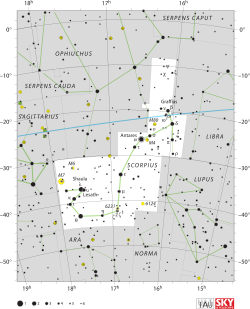Alpha Scorpii
| Observation data Epoch J2000 Equinox J2000 |
|
|---|---|
| Constellation | Scorpius |
| Right ascension | 16h 29m 24.45970s |
| Declination | −26° 25′ 55.2094″ |
| Apparent magnitude (V) | 0.6 - 1.6 + 5.5 |
| Characteristics | |
| Evolutionary stage | Red supergiant |
| Spectral type | M1.5Iab + B2.5V |
| U−B color index | +1.34 |
| B−V color index | +1.83 |
| Variable type | Lc |
| Astrometry | |
| Radial velocity (Rv) | −3.4 km/s |
| Proper motion (μ) |
RA: −12.11 mas/yr Dec.: −23.30 mas/yr |
| Parallax (π) | 5.89 ± 1.00mas |
| Distance | approx. 550 ly (approx. 170 pc) |
| Absolute magnitude (MV) | −5.28 |
| Details | |
| A | |
| Mass | 12.4 M☉ |
| Radius | 883 R☉ |
| Luminosity | 57,500 L☉ |
| Surface gravity (log g) | 0.1 cgs |
| Temperature | 3400 ± 200 K |
| Rotational velocity (v sin i) | 20 km/s |
| B | |
| Mass | 7.2 M☉ |
| Radius | 5.2 R☉ |
| Surface gravity (log g) | 3.9 cgs |
| Temperature | 18,500 K |
| Rotational velocity (v sin i) | 250 km/s |
| Other designations | |
| A: HD 148478, AAVSO 1623-26 | |
| B: HD 148479 | |
| Database references | |
| SIMBAD | Antares |
| Antares A | |
| Antares B | |
Antares (/ænˈtɑːriːz/), also designated Alpha Scorpii (α Scorpii, abbreviated Alpha Sco, α Sco), is on average the fifteenth-brightest star in the night sky, and the brightest star in the constellation of Scorpius. Distinctly reddish when viewed with the naked eye, Antares is a slow irregular variable star that ranges in brightness from apparent magnitude +0.6 to +1.6. Often referred to as "the heart of the scorpion", Antares is flanked by Sigma and Tau Scorpii in the centre of the constellation.
Classified as a red supergiant of spectral type M1.5Iab, Antares is one of the largest known stars. It is the brightest, most massive, and most evolved stellar member of the nearest OB association (the Scorpius–Centaurus Association). Antares is a member of the Upper Scorpius subgroup of the Scorpius–Centaurus Association, which contains thousands of stars with mean age 11 million years at a distance of approximately 145 parsecs (470 ly). It is thought to be between 15 and 18 times as massive as the Sun, and have around 883 times its radius. Hence, if placed in the center of the Solar System, its outer surface would lie between the orbits of Mars and Jupiter.
...
Wikipedia

